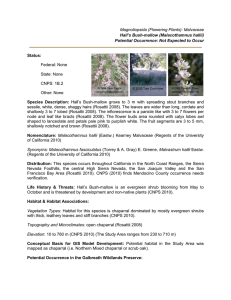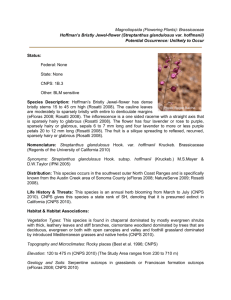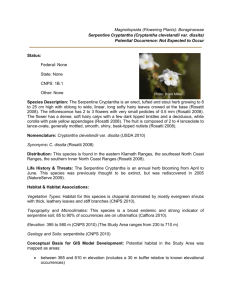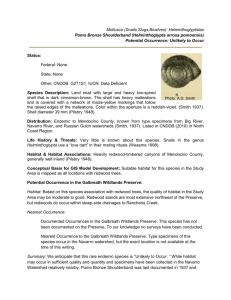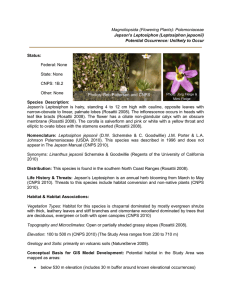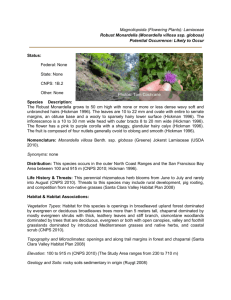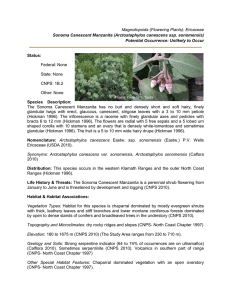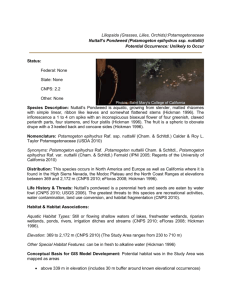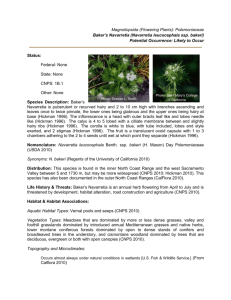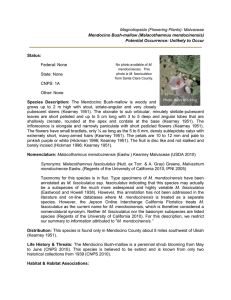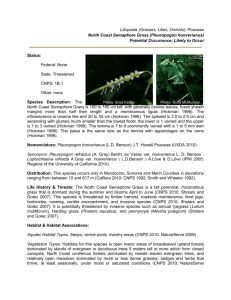DINO Text - Sonoma State University
advertisement
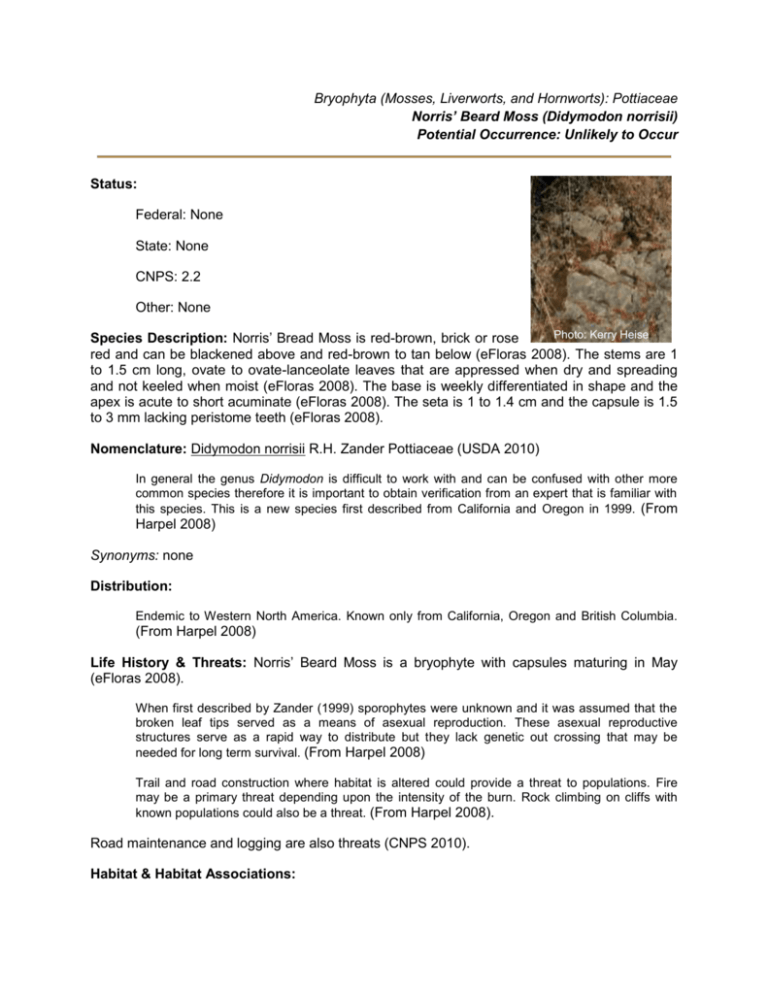
Bryophyta (Mosses, Liverworts, and Hornworts): Pottiaceae Norris’ Beard Moss (Didymodon norrisii) Potential Occurrence: Unlikely to Occur Status: Federal: None State: None CNPS: 2.2 Other: None Photo: Kerry Heise Species Description: Norris’ Bread Moss is red-brown, brick or rose red and can be blackened above and red-brown to tan below (eFloras 2008). The stems are 1 to 1.5 cm long, ovate to ovate-lanceolate leaves that are appressed when dry and spreading and not keeled when moist (eFloras 2008). The base is weekly differentiated in shape and the apex is acute to short acuminate (eFloras 2008). The seta is 1 to 1.4 cm and the capsule is 1.5 to 3 mm lacking peristome teeth (eFloras 2008). Nomenclature: Didymodon norrisii R.H. Zander Pottiaceae (USDA 2010) In general the genus Didymodon is difficult to work with and can be confused with other more common species therefore it is important to obtain verification from an expert that is familiar with this species. This is a new species first described from California and Oregon in 1999. (From Harpel 2008) Synonyms: none Distribution: Endemic to Western North America. Known only from California, Oregon and British Columbia. (From Harpel 2008) Life History & Threats: Norris’ Beard Moss is a bryophyte with capsules maturing in May (eFloras 2008). When first described by Zander (1999) sporophytes were unknown and it was assumed that the broken leaf tips served as a means of asexual reproduction. These asexual reproductive structures serve as a rapid way to distribute but they lack genetic out crossing that may be needed for long term survival. (From Harpel 2008) Trail and road construction where habitat is altered could provide a threat to populations. Fire may be a primary threat depending upon the intensity of the burn. Rock climbing on cliffs with known populations could also be a threat. (From Harpel 2008). Road maintenance and logging are also threats (CNPS 2010). Habitat & Habitat Associations: Vegetation Types: Habitat for this species is intermittently mesic rocks in cismontane woodland dominated by trees that are deciduous, evergreen or both with open canopies, lower montane coniferous forests dominated by open to dense stands of conifers and broadleaved trees in the understory, chaparral and fields (CNPS 2010; eFloras 2008; Harpel 2008). Topography and Microclimates: Full sun (Whittemore 2010) Open oak and chaparral forests (Harpel 2008) Elevation: 200 to 1973 m (CNPS 2010; Heise 2008) (The Study Area ranges from 200 to 740 m). Geology and Soils: seasonally wet rock (Whittemore 2010). Dry wash, dry sunny boulders (Zander 1999) rocky drainages (Dillingham 2006). Didymodon norrisii is restricted to rock substrate with some sheet drainage of water in low to moderate elevations (200-1500 m). Serpentine, calcareous, and volcanic boulders and outcrops in fields, cliffs, and runoff areas are typical habitat for this densely matted moss (From Heise 2008) Species Associations: Occurrences in grassland above Blue Oak (Quercus douglasii) stands and in open Oak (Quercus sp.) forests have been noted (Harpel 2008). Conceptual Basis for GIS Model Development: Potential habitat in the Study Area was mapped as: Drainages and cliffs in areas with: o Cismontane woodlands (i.e., mixed, mixed montane, or single dominant hardwoods with canopy cover 10 to 40%) o Coniferous forests o Chaparral (i.e., northern mixed chaparral and scrub oak) o Grasslands No data are available for rocky outcrops in the Study Area. Potential Occurrence in the Galbreath Wildlands Preserve: Habitat: Norris’ Beard Moss is found on rocks (typically serpentine, volcanic, or calcareous) often in drainages running though grasslands, chaparral, cismontane or coniferous forests. Habitat quality for this species is likely poor in the Preserve. Rocks in the Preserve are comprised of sandstone, siltstone, shale and schist. In addition, this species has been impacted by logging in other areas of its range; the Preserve has a long history of logging before 2000) which may have negatively affected habitat quality in the past. Timber harvest plans indicate that both clear cut and selection cut methods were used to harvest Redwood, Douglas Fir, and hardwoods at least between 1988 and 2000. Areas of best potential habitat are likely along the rocky portions of drainages that dry during the summer – such as the mainstem of Rancheria Creek. Habitat quantity may be greater than that indicated in Figure 4 if potential habitat occurs on rock outcrops away from drainages. Rock outcrops are abundant in all areas of the Preserve. Nearest Occurrence: Documented Occurrences in the Galbreath Wildlands Preserve: Previous species list for the Galbreath Wildlands Preserve did not document this species (SSU Field Station and Nature Preserves 2010). Nearest Occurrence to the Galbreath Wildlands Preserve: This species is documented in mountainous areas (coast ranges and sierras) of northern California (9 counties), central California (8 counties)(Calflora 2010). It is known from one occurrence in Mendocino County (Calflora 2010) in the outer coast range and 9 occurrences in the inner coast ranges in Lake County. The nearest occurrence is approximately 18 miles northeast of the Galbreath Wildlands Preserve in Lake County in the Upper Cache Creek watershed (Calflora 2010). Occurrence of this species on the Galbreath Wildlands Preserve would constitute a slight southern range extension in the north coast ranges. Summary: We anticipate Norris’ Beard Moss to be “Unlikely to Occur” due to the lack of typical rock substrate types and a history of logging on the Preserve. References Calflora. 2010. Information on California plants for education, research and conservation.<http://www.calflora.org/>. Accessed 2010 Jun 23. California Native Plant Society (CNPS). 2010. Inventory of Rare and Endangered Plants. Online edition, v7-10b. <http://www.cnps.org/inventory>. Accessed 2010 Jun 24. Dillingham CP. 2006. Nonvascular botanical filed reconnaissance report Plumas National Forest Feather River Ranger District. <http://www.fs.fed.us/vms/localresources/documents/Straw_nonvasc_Reconnaissance.pdf>. Accessed 2010 Jul 11. eFloras 2008. Flora of North American. Published on the Internet < http://www.efloras.org>. Accessed 2010 Jun 27. Harpel JA. 2008. Species Fact Sheet. <http://www.fs.fed.us/r6/sfpnw/issssp/documents/planning-docs/sfs-br-didymodon-norrisii-200810.doc.>. Accessed 2010 Jul 11. Heise K. 2008. Final Report on the Botanical Resources of Cave Creek Tomki Road Feasibility Study Mendocino County, California. <http://www.co.mendocino.ca.us/dot/pdf/Appendix%20F%20%20%20Botanical%20Report.pdf>. Accessed 2010 Jul 11. SSU Field Stations and Nature Preserves. 2010. Galbreath Wildlands Preserve Vascular Plant List. Compiled by CNPS Milo Baker Chapter, Linden Schneider, and others. <http://www.sonoma.edu/preserves/docs/galbreath_vascular_plants.pdf>. Accessed 2010 Jun. United States Department of Agriculture (USDA). 2010. PLANTS Profile. <http://plants.usda.gov/java/nameSearch?mode=symbol&keywordquery=DINO3>. Accessed 2010 Jul 17. Whitmore A. 2010. Mosses of the San Francisco Bay Area. <http://bryolog.com/treatment.html>. Accessed 2010 Jul 11. Zander RH. 1999. A New Species of Didymodon (Bryopsida) from Western North America and a Regional Key to the Taxa. The Bryologist 102: 112-5. Species Account Description: Linden Schneider

